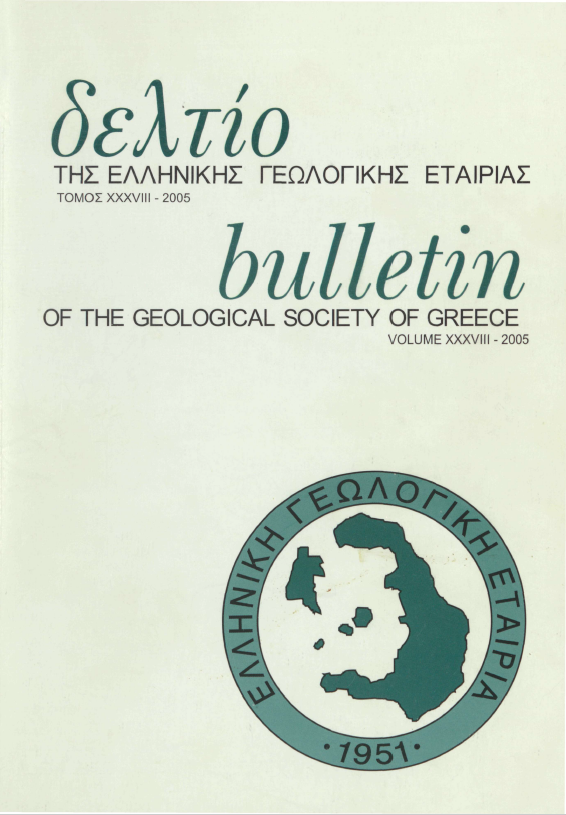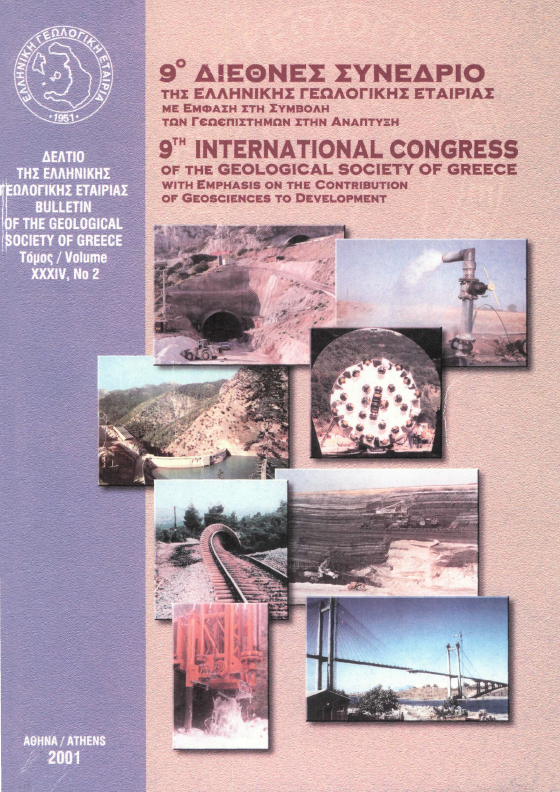Συμβολή στη μελέτη των γεωττυραμιδικών σχηματισμών (γεωμυθότοπων) της κοιλάδας της Ποτάμιας των δυτικών Καμβουνίων (Τρανόβαλτου Σέρβιων Κοζάνης)
Abstract
In recently dissected ravines of the river Potamia valley on the Mt. Kamvounia (Tranovalto village, Servia, Kozani) occur conical, or column, mushroom forms known in geomorphology as pyramids or earth pillars. Local people call them "Boucharia" meaning chimneys. The relief data reveal a two cycle development. During the first cycle the rocks on the Pliocene surface of the Mt. Kamvounia were eroded. The Pleistocene valleys thus produced gradually filled up with continental deposits mainly red beds. The climatic fluctuations towards the upper Pleistocene affected the weathered rocks of Kamvounia and produced episodic mudflows or debris flows. Various clastic material of the regolith transported during these episodic flows and deposited in the valleys as tongues of limited aerial extend. They consist of heterogenous, chaotic, graded (coarsening up) structures, carrying on their top large boulders of schist or gneiss. Younger red beds deposits covered and protected the episodic mudflow deposits. The investigated case of "Boucharia" consist of a tongue of mudflow deposits 2200 m long, 300 m wide and 2 - 1 1 m thick, on altitudes of 760 m to 670 m, covered with red beds. During the second cycle the Pleistocene regime of deposition was succeeded by the Holocene regime of erosion. The red beds and the enclosed mudflow deposits were eroded by surface flows and the new ravines were formed. The large boulders on the top surface of the mudflow deposits resisted to erosion and protected the underlain materials as cap rocks. In between the material was removed by erosion. So, under every large boulder an earth pillar or pyramid was formed, all along the area of a mudflow tongue. The still active erosional processes continue to remove material from the area, to weaken and gradually destroy the earth pillars all along the sides of the new ravines. The loose mudflow deposits are not able to resist erosion, so the cap rocks usually collapse and the earth pillars are destroyed.The geopyramids, or "Boucharia" in our case, are connected with local myths or superstitions. They can be developed as site views in geoparks for recreation, tourism and education as well.
Article Details
- How to Cite
-
ΨΙΛΟΒΙΚΟΣ Α., ΜΑΡΓΩΝΗ Σ., ΜΟΥΜΟΥ Χ., ΜΟΥΡΤΖΙΟΣ Π., ΠΕΧΛΙΒΑΝΙΔΟΥ Σ., & ΤΣΙΛΙΟΣ Σ. (2005). Συμβολή στη μελέτη των γεωττυραμιδικών σχηματισμών (γεωμυθότοπων) της κοιλάδας της Ποτάμιας των δυτικών Καμβουνίων (Τρανόβαλτου Σέρβιων Κοζάνης). Bulletin of the Geological Society of Greece, 38, 134–146. https://doi.org/10.12681/bgsg.18433
- Section
- Geomorphology

This work is licensed under a Creative Commons Attribution-NonCommercial 4.0 International License.
Authors who publish with this journal agree to the following terms:
Authors retain copyright and grant the journal right of first publication with the work simultaneously licensed under a Creative Commons Attribution Non-Commercial License that allows others to share the work with an acknowledgement of the work's authorship and initial publication in this journal.
Authors are able to enter into separate, additional contractual arrangements for the non-exclusive distribution of the journal's published version of the work (e.g. post it to an institutional repository or publish it in a book), with an acknowledgement of its initial publication in this journal. Authors are permitted and encouraged to post their work online (preferably in institutional repositories or on their website) prior to and during the submission process, as it can lead to productive exchanges, as well as earlier and greater citation of published work.







